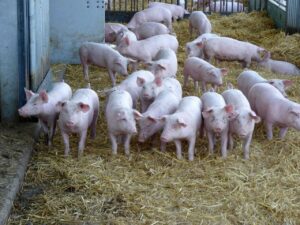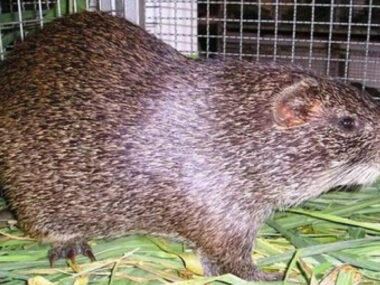Pig husbandry, also known as swine management, encompasses the care, breeding, and management practices involved in raising pigs for various purposes, including meat production, breeding stock, and research. Whether on small family farms or large commercial operations, successful pig husbandry requires attention to detail, knowledge of pig behavior, and adherence to best practices for animal welfare and productivity. Here’s an in-depth exploration of pig husbandry:

Breeds of Pigs: Pig breeds vary widely in size, color, temperament, and suitability for different production systems. Some popular pig breeds include:
Yorkshire: Yorkshire pigs are large white pigs known for their excellent maternal qualities, prolificacy, and fast growth rates. They are commonly used in crossbreeding programs to improve carcass quality and mothering abilities.
Duroc: Duroc pigs are reddish-brown in color and prized for their meat quality, including marbling and flavor. They are known for their efficient feed conversion and growth rates, making them popular in commercial pork production.
Hampshire: Hampshire pigs are black with a white belt around their shoulders and front legs. They are valued for their meat quality, including lean muscle growth and desirable carcass traits.
Landrace: Landrace pigs are white with large, drooping ears and known for their prolificacy, mothering abilities, and strong maternal instincts. They are commonly used in crossbreeding programs to improve litter size and piglet survival rates.
Housing and Facilities Proper housing and facilities are essential for the health, comfort, and productivity of pigs. Important considerations for pig housing include:
Ventilation: Adequate ventilation is crucial to prevent respiratory issues and maintain optimal air quality within pig housing facilities.
Temperature Control: Pigs are sensitive to temperature extremes, so housing should provide adequate insulation and ventilation to regulate temperature and prevent heat stress or hypothermia.
Space Requirements: Pigs require sufficient space to move, rest, and socialize. Overcrowding can lead to aggression, stress, and poor welfare, so housing should be designed to accommodate the number and size of pigs being raised.
Waste Management: Proper waste management is essential to prevent odors, flies, and disease transmission. Manure should be regularly removed and properly disposed of to maintain a clean and sanitary environment for pigs.
Nutrition and Feeding: A balanced diet is crucial for the health, growth, and productivity of pigs. Key considerations for pig nutrition and feeding include:
Feed Composition: Pig diets should be formulated to meet their nutritional requirements for protein, energy, vitamins, and minerals at different stages of growth and production.
Feeding Schedule: Pigs should be fed according to a consistent schedule to promote healthy eating habits and optimal growth rates. Feed should be provided in clean, well-maintained feeders to minimize waste and contamination.
Water Supply: Access to clean, fresh water is essential for pigs’ hydration, digestion, and overall health. Water should be available at all times and provided in clean, leak-proof drinkers to prevent contamination.
Feed Efficiency: Efficient feed conversion is crucial for maximizing productivity and profitability in pig production. Feeding strategies should aim to optimize feed efficiency while meeting pigs’ nutritional needs and minimizing waste.
Health and Disease Management: Preventing and managing diseases is essential for maintaining the health and welfare of pigs and maximizing productivity. Important aspects of pig health and disease management include:
Vaccination: Vaccination is an important preventive measure to protect pigs against common infectious diseases such as porcine reproductive and respiratory syndrome (PRRS), swine influenza, and erysipelas. Vaccination protocols should be developed in consultation with a veterinarian based on the specific disease risks and management practices.
Biosecurity: Biosecurity measures are essential for preventing the introduction and spread of diseases on pig farms. These may include controlling access to the farm, implementing strict sanitation protocols, and practicing proper hygiene and disinfection procedures.
Parasite Control: Internal and external parasites can negatively impact pig health and productivity. Regular deworming and parasite control measures should be implemented to minimize parasite burdens and maintain optimal health.
Monitoring and Surveillance: Regular monitoring and surveillance of pig health and performance indicators, such as feed intake, weight gain, and mortality rates, can help detect early signs of disease or management issues and implement timely interventions.
Reproduction and Breeding: Successful reproduction and breeding are essential for maintaining and improving the genetic quality and productivity of pig herds. Key aspects of pig reproduction and breeding include:
Estrus Detection: Monitoring and detecting estrus (heat) in female pigs is crucial for successful breeding. Signs of estrus may include restlessness, mounting behavior, and increased vocalization. Estrus detection aids in timing artificial insemination or natural mating to maximize conception rates.
Boar Management: Boars play a critical role in pig reproduction as sires of piglets. Proper boar management, including regular health checks, semen evaluation, and breeding soundness examinations, is essential for maintaining fertility and reproductive performance.
Breeding Programs: Breeding programs should be designed to achieve specific goals related to pig performance, health, and product quality. This may involve selecting superior breeding stock based on traits such as growth rate, feed efficiency, carcass quality, and disease resistance.
Pregnancy Management: Once pregnant, sows require proper care and management to support fetal development and ensure successful farrowing. This includes providing appropriate nutrition, housing, and veterinary care throughout gestation to optimize sow and litter health.
Handling and Welfare: Proper handling and welfare practices are essential for promoting the health, well-being, and behavioral needs of pigs. Key considerations for pig handling and welfare include:
Gentle Handling: Pigs are sensitive animals that respond well to calm, gentle handling techniques. Rough or aggressive handling can cause stress, injury, and behavioral issues, so caregivers should be trained in proper pig handling methods.
Enrichment: Enrichment activities and environmental enhancements, such as rooting materials, toys, and social interactions, are important for stimulating natural behaviors and preventing boredom and aggression in pigs.
Pain Management: Pain management protocols should be implemented to minimize discomfort and distress associated with common procedures such as castration, tail docking, and teeth clipping. Pain relief measures may include analgesics, local anesthesia, or other pain mitigation strategies.
Monitoring and Assessment: Regular monitoring and assessment of pig welfare indicators, such as body condition, behavior, and health status, are essential for identifying and addressing
welfare concerns. Caregivers should be vigilant for signs of stress, injury, or disease and take prompt action to address any issues.
In conclusion, pig husbandry encompasses a wide range of practices and considerations aimed at ensuring the health, welfare, and productivity of pigs in various production systems. By implementing sound management practices, addressing the specific needs of pigs at different stages of growth and production, and prioritizing animal welfare, pig producers can optimize performance, enhance profitability, and contribute to sustainable and responsible agriculture.










